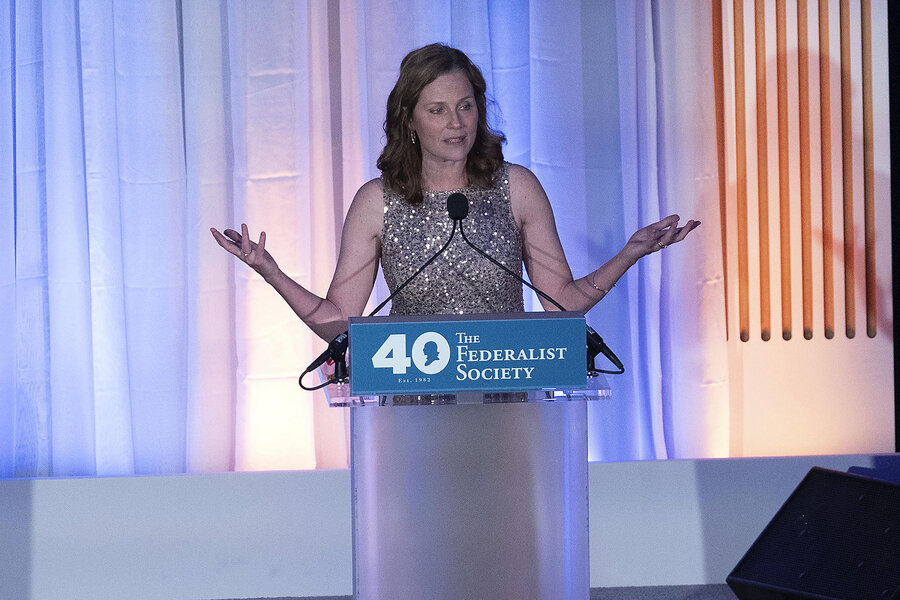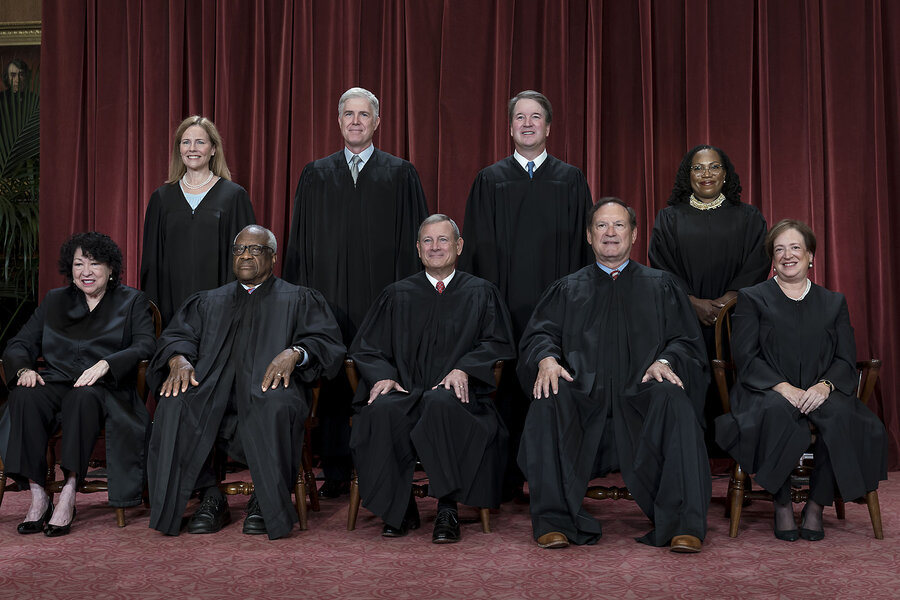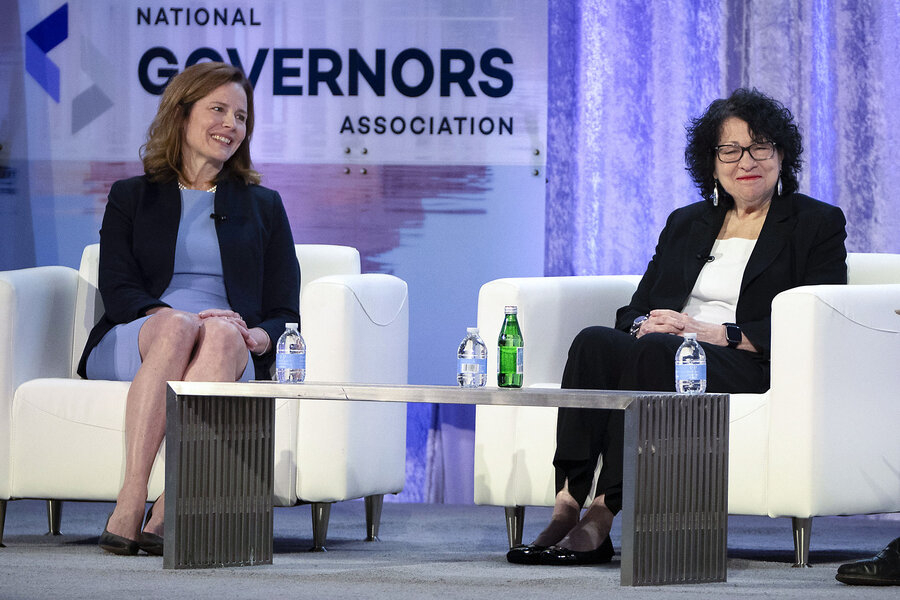Prior to this term, it was difficult for court watchers to distinguish Justice Amy Coney Barrett from the rest of the high court’s six-justice conservative supermajority.
But she has established herself as an independent voice on hot-button issues ranging from abortion and gun rights to immunity for former President Donald Trump.
Why We Wrote This
At a time when a majority of Americans believe the high court makes decisions based on ideology rather than the law, Justice Amy Coney Barrett has quietly charted an independent path, even on hot-button issues.
And she’s beginning to stand out. To everyone.
“Barrett has decided she’s a politician, not a justice,” said conservative lawyer Mark Levin on his podcast. “By the end of her term, I believe [she] will have flipped all the way to the left.”
His comments came the day the court decided a high-profile social media case brought by conservatives who claimed they were being silenced online. The court dismissed the case on the grounds plaintiffs couldn’t establish a concrete injury.
Writing for the bipartisan majority, Justice Barrett criticized lower courts for “gloss[ing] over complexities in the evidence” and relying on “clearly erroneous” factual findings.
That commitment to judicial rigor – at the expense of conservative policy goals – also manifested in other rulings.
Her positions came “because of the law, and her view of what the law required,” says law professor Jonathan Adler. “She cares about getting things right for the right reasons.”
The U.S. Supreme Court is a notoriously difficult workplace to join. But perhaps not if you’re already coming from a family of nine.
Amy Coney Barrett cracked that joke at the ceremony announcing her nomination to the high court in 2020. Over the ensuing four terms, it has become less a joke and more an asset. Making yourself heard amidst nine different voices is a valuable skill for a justice, it turns out.
And it has helped Justice Barrett become perhaps the most intriguing – and most scrutinized – member of the court.
Why We Wrote This
At a time when a majority of Americans believe the high court makes decisions based on ideology rather than the law, Justice Amy Coney Barrett has quietly charted an independent path, even on hot-button issues.
After a few hints in prior years, this term she has established herself as an independent and intellectually principled jurist. In oral arguments and in written opinions on hot-button issues ranging from abortion and gun rights to immunity for former President Donald Trump, she has displayed a conservative but disciplined approach to the law.
In particular, she has sought to provide more guidance for lower court judges. And on a court where broad rulings often breed division, she has been building consensus through her diligent and methodical analysis of legal text and history. Foreshadowing a longer-term debate, she has criticized some conservative colleagues for how they interpret the original meaning of the Constitution.
She has likewise dressed-down liberal justices for what she sees as alarmist rhetoric. And with the public growing increasingly sour on a high court it views as dogmatically divided along ideological lines, the first ever justice to be the mother of school-age children is proving a breath of fresh air.
“She has been a very impressive justice. She certainly is not hesitating to go her own way,” says Michael McConnell, a professor at Stanford Law School and a former federal appeals court judge.

Supreme Court Justice Amy Coney Barrett speaks during The Federalist Society’s 40th anniversary at Union Station in Washington, Nov. 10, 2022.
“She may be [unpredictable], though I don’t think unpredictable is a bad thing,” he adds. “If you care more about how constitutional meaning is discerned than you care about how cases come out, you may look unpredictable to people who only care about how cases come out.”
“Getting things right for the right reasons”
Prior to this term, it was difficult for many court watchers to distinguish Justice Barrett from the rest of the high court’s six-justice, deeply conservative supermajority.
Before becoming a three-time professor of the year at the University of Notre Dame Law School in Indiana, she clerked for the conservative legal titan Justice Antonin Scalia. Since she joined the court, she’s voted for conservative policy objectives like overturning Roe v. Wade, abolishing affirmative action in college admissions, and expanding gun rights.
But now she’s beginning to stand out. To everyone.
“Barrett has decided she’s a politician, not a justice,” said Mark Levin, a lawyer and conservative commentator, on his podcast last month.
“By the end of her term,” he added, “I believe [she] will have flipped all the way to the left.”
His comments came the day the court decided a high-profile social media case brought by conservatives who claimed the Biden White House was trying to silence users online. The court dismissed the case on the grounds plaintiffs couldn’t establish a concrete injury.
Writing for the bipartisan, six-justice majority, Justice Barrett criticized lower courts in the case for “gloss[ing] over complexities in the evidence” and relying on “clearly erroneous” factual findings.
That commitment to judicial rigor – at the expense of conservative policy goals – manifested in other rulings. Concerns over procedural flaws convinced her to, in one case, vote to retain access to a widely used abortion pill, and in another case to temporarily allow hospitals in Idaho to continue performing emergency abortions.
In oral arguments in both cases, she focused questions on already-existing federal conscience protections for hospital employees who have religious objections to providing abortion-related care. Both final opinions pointed to those protections as an important tool for compromise.
“At least at present there is a foundation, that cuts across the whole country, of at least some conscience protections for medical professionals,” says Richard Garnett, a professor and former colleague of Justice Barrett’s at the University of Notre Dame Law School.
Justice Barrett also broke from her conservative colleagues in high-profile cases involving Mr. Trump. In one, she dissented from a court ruling vacating obstruction charges against Jan. 6 defendants. (Her fellow conservatives, she critiqued, performed “textual backflips.”) In another, she wrote separately to take issue with aspects of the majority’s holding that former presidents have a degree of immunity from criminal prosecution.
Her positions in those cases came “because of the law, and her view of what the law required,” says Jonathan Adler, a professor at Case Western Reserve University School of Law.
“She cares about getting things right for the right reasons,” he adds. That has meant voting “against what one might have thought would be her policy preferences.”
The history test
In the realm of constitutional interpretation, this approach has also seen her emerge as a leading reformist in what is now the dominant legal theory on the Supreme Court.

J. Scott Applewhite/AP/File
Members of the U.S. Supreme Court sit for a group portrait Oct. 7, 2022. Bottom row, from left, Justice Sonia Sotomayor, Justice Clarence Thomas, Chief Justice John Roberts, Justice Samuel Alito, and Justice Elena Kagan. Top row, from left, Justice Amy Coney Barrett, Justice Neil Gorsuch, Justice Brett Kavanaugh, and Justice Ketanji Brown Jackson.
Originalism, on its surface, is a simple legal philosophy: The Constitution should be interpreted in line with its original meaning, otherwise judges will just invent their own rules.
But that definition obscures an ocean of complexity – complexity that Justice Barrett is now articulating. What’s more, she’s articulating it in opposition to Justice Clarence Thomas, the current court’s foremost originalist.
Two years ago, his majority opinion in New York State Rifle & Pistol Association, Inc. v. Bruen held that gun laws must be consistent with America’s history and tradition of firearm regulation. The decision soon caused widespread confusion among lower courts tasked with applying a new history and tradition test.
Justice Barrett was part of the Bruen majority, but this term she has helped lead the way in clarifying it. In an 8-1 decision holding that the government can temporarily take guns from people subject to domestic violence restraining orders, she wrote separately to detail how she sees originalism applying to modern-day law.
“For an originalist, the history that matters most is the history surrounding the ratification of the text,” she wrote, not “scattered cases or regulations pulled from history.”
But her most pointed criticism of Thomas-style originalism came in a little-watched trademarks case. While she joined Justice Thomas’s majority, she wrote a concurrence that rebuked Bruen’s core philosophy.
“Relying exclusively on history and tradition may seem like a way of avoiding judge-made tests,” she wrote. “But a rule rendering tradition dispositive is itself a judge-made test.”
“The court’s laser-like focus on the history,” she added, “misses the forest for the trees.”
This rift is unsurprising, experts say. Throughout history, “the bigger a social movement gets, the more likely you’re going to have factions inside it,” says Christine Bird, an assistant professor of political science at Oklahoma State University.
Originalist scholars view the disagreement as less a fundamental difference of opinion, and more a result of the philosophy moving with breathtaking speed from legal theory to practice.
Several justices expressed “a lot of unhappiness … about what Bruen had wrought,” says Keith Whittington, a political science professor at Princeton University.
Justice Barrett “wants to provide the lower courts with a lot more guidance,” he adds. It helps that, since her time as an academic, she has been “thinking through the puzzles of how to articulate originalist methods clearly and deeply.”

Mark Schiefelbein/AP/File
U.S. Supreme Court Justices Amy Coney Barrett (left) and Sonia Sotomayor speak during a panel discussion at the National Governors Association, Feb. 23, 2024, in Washington. Conservative Justice Barrett and liberal Justice Sotomayor said a Supreme Court where voices don’t get raised in anger can be a model for the rest of the country in polarized times.
As originalism continues its rise from the pages of law review articles to the day-to-day workings of federal judges, she could have a major influence over how the theory – and American law – evolves.
“She’s playing a long game,” says Professor Whittington. “She’s thinking about what the future of the conservative legal movement might look like, and how it should think about these big ideas.”
“Justice Thomas has been a lead defender of originalism and a lead proponent,” he adds, “but he’s not the only game in town.”
“She’s … more of a Sandra Day O’Connor”
While she departs from her most conservative colleagues in some ways, she has built consensus with other members of the court – at least in the short term. That includes the liberal wing, which consists of all of her fellow women justices, and also Chief Justice John Roberts and Justice Brett Kavanaugh, with whom she votes most often.
There was a concern among some liberals that she would be more of an uncompromising originalist, says Professor Bird.
“But it seems to me she’s operating as more of a Sandra Day O’Connor,” she adds. “She’s amenable to bipartisan negotiation, she’s amenable to bargaining in a way that [I was] surprised by.”
Thus, several high-profile cases have been resolved with bipartisan opinions on procedural grounds. Some conservatives have condemned these rulings, but Justice Barrett also hasn’t been shy in criticizing her liberal colleagues. When the court unanimously dismissed a case seeking to remove Mr. Trump from Colorado’s 2024 presidential primary ballot, she wrote separately to rebut the liberals’ opinion criticizing the breadth of the ruling.
“This is not the time to amplify disagreement with stridency,” she wrote. “Particularly in this circumstance … the Court should turn the national temperature down, not up. For present purposes, our differences are far less important than our unanimity.”
There may be no better encapsulation of a term in which she has crafted a path of independence and consensus-building on a court often defined by its divisions. While that may surprise some, for Professor Garnett – who is also her former neighbor – it’s no surprise at all.
“She was a great teacher and a generous colleague, and a very careful and valuable scholar,” he says.
Looking ahead, her demeanor and her intellect will likely only become more important. “Harder … problems,” she acknowledged in her gun rights opinion, “await another day.”
>>> Read full article>>>
Copyright for syndicated content belongs to the linked Source : The Christian Science Monitor – https://www.csmonitor.com/USA/Justice/2024/0714/supreme-court-amy-coney-barrett?icid=rss










